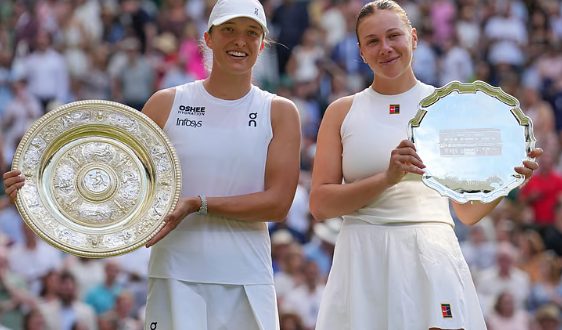The second weekend of July 2025 delivered two very different Wimbledon finals. Both told us something about form, mindset, and what readiness on grass looks like.
Women’s Final: Wimbledon’s Shortest Final in Years
Iga Swiatek captured her maiden Wimbledon crown with a commanding 6-0, 6-0 win over Amanda Anisimova, closing out the final in just 57 minutes. It was only the second “double bagel” in a women’s final at Wimbledon in the Open Era; a rare feat that underlined the measurement of her performance. Anisimova, born in Russia and representing the US, arrived in the final riding the high of a dramatic and emotional semifinal victory over Sabalenka. That earlier match showcased her grit and ability to wrest momentum when it mattered. But against Swiatek, she found no foothold. From the very first rally, Swiatek looked dialled in; sharp, focused, and fully in control. Grass has long been considered Swiatek’s least natural surface. She has dominated Roland Garros and posted strong results on hard courts, but Wimbledon remained elusive – until now. That she won it was notable enough. But to do so with this level of dominance, especially over a player who had just ousted Aryna Sabalenka, suggests a significant shift in her grass-court game. Swiatek’s movement, timing, and decision-making were seamless. She played with intensity but never rushed. There was no need for dramatics – her brand of pressure was applied steadily and with clarity. Anisimova, meanwhile, seemed to unravel. Her serve lacked bite, and her body language faded early. By 0-3 in the first set, she appeared overwhelmed. Swiatek, known for her clinical mindset, didn’t let the momentum slip.
Anisimova’s semifinal win had been draining – not just physically, but emotionally. The energy required to defeat Sabalenka may have emptied her reserves. Against Swiatek, her timing was off, her shots tentative, and her decisions rushed. The serve – often a stabilizer under pressure – became predictable, underpowered, and exposed. It wasn’t a lack of effort but a mismatch in rhythm and readiness. Swiatek sensed nerves and elevated her game accordingly. Her returns were crisp, and she gave Anisimova no time to settle. Every opportunity was seized quickly and without hesitation. While Swiatek’s brilliance defined the final, the absence of Aryna Sabalenka loomed in the background. The Belarusian is one of the few players who can push Swiatek physically and disrupt her timing with raw power. Had she reached the final, the dynamic might have been very different – more volatile, perhaps, if not with a different outcome. Instead, Swiatek faced a less aggressive, less experienced opponent. She capitalized on that with composure and intensity. There were no dips in focus, no signs of nerves. It was a clean, high-level performance from start to finish. At 6-0, 5-0, many players might ease off slightly; offer a soft point or relax the grip. Swiatek didn’t. She kept chasing balls with the same energy she started with. No performative sympathy, no hollow gestures of consolation. Just clarity of purpose. Her post-match speech was gracious and composed. She thanked the crowd, acknowledged her opponent, and kept the focus on the moment – not on drama.
Swiatek’s win in the women’s final was extraordinary in its clarity – not just because of the double bagel scoreline, but because of the psychological weight it carried. She didn’t just outplay Anisimova – she denied her any oxygen. A rare occasion for a match at this level. There is a bit of efficiency in it – but also her refusal to blink. Since COVID, Wimbledon’s women’s finals have followed a pattern that feels emotionally unresolved – triumphant winners beside shattered runners-up. Ons Jabeur was twice that runner-up. In 2025, it was Anisimova. The Centre Court crowd, sympathetic and subdued, applauded her with restraint. Swiatek didn’t just win Wimbledon – she showed she belongs there. And she did it not through theatrics, but through mastery.
Men’s Final: Four Balancing Sets with a Twist
Sunday’s final was a different story. It offered a long, balanced match between two rising forces: Carlos Alcaraz, the defending champion, and Italy’s Jannik Sinner. Alcaraz started strong, taking the first set with confident baseline play and sharp movement. But Sinner adjusted quickly. Across the next three sets, he stayed calm, tightened his patterns, and outmaneuvered his opponent. The final score: 4-6, 6-3, 6-4, 6-4. The match wasn’t about dramatic swings. Long rallies, clean net work, and strategic pressure were on display. While Alcaraz brings flash and force, Sinner brought consistency and control. His 7-1 grass court record coming into the tournament wasn’t a fluke. He looked composed, confident, and ready with serve that was especially reliable. He managed high-pressure moments with ease, while Alcaraz struggled to break through on return games. The Italian didn’t just hang in; he steered the match. His backhand stayed firm, with second-shot decisions that were clear. The final was close throughout. Alcaraz had his chances, but his edge came and went; a little too many unforced errors for his typical play at finals. Sinner, meanwhile, stayed steady, improved movement and sharper point construction. This wasn’t an upset. It was a steady climb, breaking opponent at just the right time. In his victory speech, Sinner immediately acknowledged Alcaraz – suggesting this could be the beginning of a new grass-court rivalry. Sinner called their rivalry “special” and saying it pushes him to improve. That mutual drive has been a trait of their encounters.
On post-match social media, Alcaraz showed grace in defeat after losing the Wimbledon final to Jannik Sinner. The 22-year-old Spaniard responded to Sinner’s Instagram post: “Am I still dreaming?” – with a short but challenging comment: “Well deserved Jannik. Enjoy this moment. More to come.” The two have built a rivalry rooted in mutual respect, and Alcaraz’s message reflected that. Despite a tough loss, where frustration boiled over mid-match, he remained composed and generous in his praise. At the Olympics, a loss to Novak Djokovic had left him in tears. But this time, he handled the disappointment with maturity. Alcaraz’s loss came after Sinner played one of the best matches of his career, beating his childhood idol – Djokovic – in straight sets during the semifinals. Former champion Lindsay Davenport noted that Sinner disrupted Alcaraz’s rhythm, particularly neutralizing his powerful forehand. The Italian was aggressive yet calculated, rarely giving Alcaraz time to settle. For now, the crown has shifted. But with the US Open ahead, the rivalry continues. If this Wimbledon final is any sign, tennis fans are in for more top-level battles between these two. Sinner denied Alcaraz the chance to become the second man since Björn Borg to win the French Open and Wimbledon back-to-back in consecutive years, just as Alcaraz had denied Djokovic a few seasons earlier. Both players showed maturity beyond their age. That’s what winning early teaches you. Sinner wasn’t overwhelmed by his first Wimbledon title. Alcaraz, for his part, took the loss with grace. This wasn’t a shocking result – the margins are razor-thin. The balance keeps shifting because the bar keeps rising; a reminder of a poised, tactical win with its own twist can always happen.



